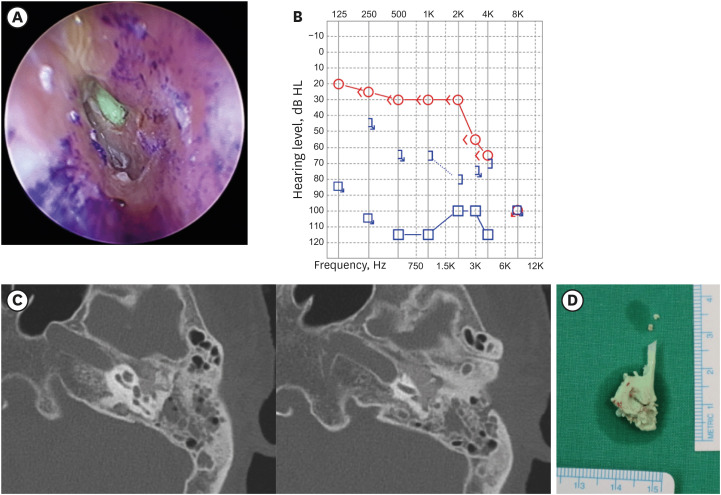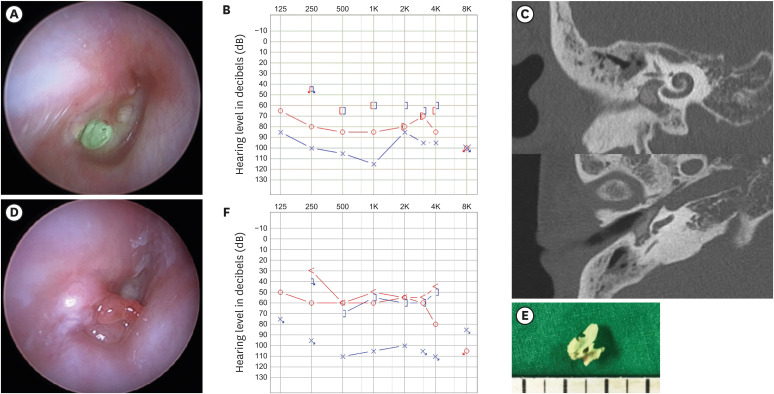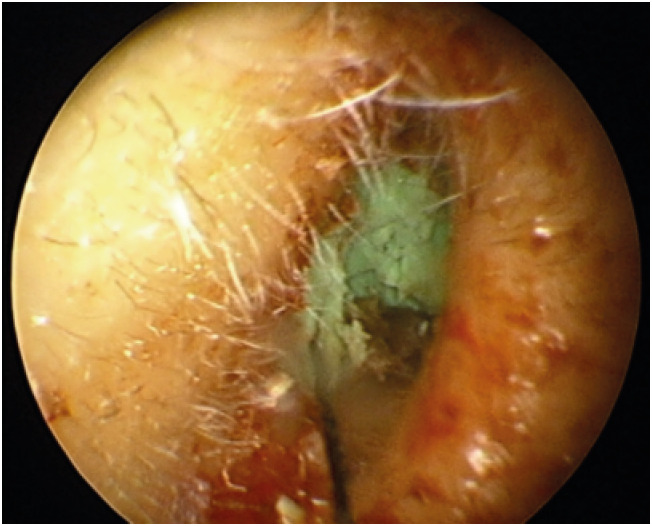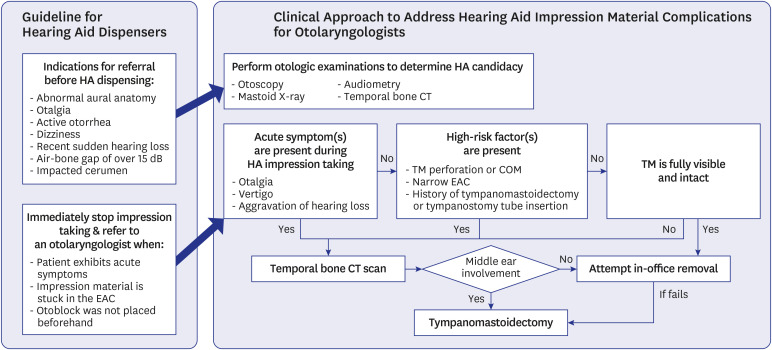J Korean Med Sci.
2022 Jan;37(2):e19. 10.3346/jkms.2022.37.e19.
Foreign Body Complications in Ears due to Mishandled Hearing Aid Fitting and Proposed Clinical Guidelines to Address the Complications
- Affiliations
-
- 1Department of Otorhinolaryngology-Head and Neck Surgery, Hallym University College of Medicine, Chuncheon, Korea
- 2Laboratory of Brain & Cognitive Sciences for Convergence Medicine, Hallym University College of Medicine, Anyang, Korea
- KMID: 2524291
- DOI: http://doi.org/10.3346/jkms.2022.37.e19
Abstract
- Background
South Korea has one of the world’s fastest aging populations and is witnessing increased age-related hearing impairment cases as well as an increase in the number of hearing aid users. The aim of this study was to analyze complications caused by hearing aid mold materials. In addition, we hope to raise awareness of the harm and danger that inexperienced hearing aid providers can cause to patients.
Methods
We retrospectively reviewed the medical records of 11 patients who were diagnosed with hearing aid mold material as a foreign body in the ear at a tertiary center between 2016 and 2020. The following data were analyzed: symptoms, endoscopic findings, audiometry, temporal bone CT images, treatment methods, and complications after removal. The currently available literature was also reviewed to develop clinical guidelines, to identify the systematic weaknesses in the South Korean hearing aid market, and to identify policies that warrant better quality control.
Results
Among the 11 cases, 9 were restricted to the external auditory canal, all of which were successfully removed under endoscopy with minor complications. Two cases with middle ear involvement resulted in infection and thus required surgical removal with mastoidectomy. The average age of these patients was 76.4, and all patients received their molding procedure at private hearing aid shops without an otolaryngologist’s examination.
Conclusion
Thorough patient history-taking and otologic examination must be performed to identify patients at higher risk of complications. Such patients should be referred to an otolaryngologist. If a patient exhibits alarming symptoms, early referral is critical since prompt surgery can minimize complications. A CT scan is highly recommended to determine an optimal approach for foreign body removal. Systematic and regulatory changes in hearing aid dispensers, such as requiring apprenticeship, raising the required level of education, and legally mandating referrals, can help reduce these complications.
Keyword
Figure
Reference
-
1. Cho SD, Jang JH, Kim H, Cho YS, Kim Y, Koo JW, et al. Ear mold foreign bodies in the middle ear necessitating surgical removal: why otology specialists should screen candidates for hearing aids. Clin Exp Otorhinolaryngol. 2021; 14(2):235–239. PMID: 32882785.2. Verdam F, Tange R, Thomeer H. Impression material in the external and middle ear: an overview of the literature and a stepwise approach for removal. J Int Adv Otol. 2016; 12(3):345–352. PMID: 27895002.
Article3. van den Boer C, van Spronsen E, Holland CT, Ebbens FA, Waterval JJ. Clinical approach after complicated ear mold fitting: a case series of six patients and evaluation of literature. Ann Otol Rhinol Laryngol. 2019; 128(12):1141–1146. PMID: 31364383.
Article4. Lee HM, Yi KI, Jung JH, Lee IW. Hearing aid silicone impression material as a foreign body in the middle ear. Am J Otolaryngol. 2017; 38(1):108–111. PMID: 27751620.
Article5. Hong JW, Jeon JH, Ku CR, Noh JH, Yoo HJ, Kim DJ. The prevalence and factors associated with hearing impairment in the Korean adults: the 2010–2012 Korea National Health and Nutrition Examination Survey (observational study). Medicine (Baltimore). 2015; 94(10):e611. PMID: 25761183.6. Kim S, Park JM, Han JS, Seo JH, Han KD, Joo YH, et al. Age-related hearing loss in the Korea National Health and Nutrition Examination Survey. PLoS One. 2020; 15(12):e0243001. PMID: 33259558.
Article7. Park HJ, Yoo MH, Baek SY, Kim SW, Cho YS. Normative hearing threshold levels in Koreans with normal tympanic membranes and estimated prevalence of hearing loss. Clin Exp Otorhinolaryngol. 2017; 10(2):129–136. PMID: 27464516.
Article8. Sim S, Kim J. A current status of centers and market for hearing aids in Korea. Audiol Speech Res. 2019; 15(3):184–195.
Article9. Chang JH, Hong CE, Park JC, Choi JK, Choi HS. Determinants analysis of satisfaction with supporting system for hearing aids. Korean J Otorhinolaryngol-Head Neck Surg. 2017; 60(8):381–389.
Article10. Korean Ministry of Health and Welfare, Division of Health Insurance Benefits. Revision of hearing aid policy for hearing-disabled goes into effect in July. Updated 2020. Accessed June 30, 2021. http://www.mohw.go.kr .11. Hearing aid dispensers made illegal profits since the raise of government financial support for hearing-disabled. Updated 2019. Accessed June 30, 2021. https://www.chosun.com/site/data/html_dir/2019/12/13/2019121300224.html .12. Extended government support for hearing aids ends up in the pockets of hearing aid providers. Updated 2019. Accessed June 30, 2021. https://www.donga.com/news/Society/article/all/20191205/98666824/1 .13. Bae S, Hwang M. Trends in Hearing-Aid-Related Complaints by Elderly Consumers and Its Implications. Eumseong, Korea: Korea Consumer Agency;2018.14. Kohan D, Sorin A, Marra S, Gottlieb M, Hoffman R. Surgical management of complications after hearing aid fitting. Laryngoscope. 2004; 114(2):317–322. PMID: 14755211.
Article
- Full Text Links
- Actions
-
Cited
- CITED
-
- Close
- Share
- Similar articles
-
- General Framework of Hearing Aid Fitting Management
- A Case of External Auditory Canal Inflammatory Polyp Induced by a Hearing Aid Mold Impression Foreign Body
- A Case of Foreign Bodies in Middle Ear and Eustachian Tube When Making Impression of Hearing Aid
- Pole-Zero Fitting for Transfer Function of Hearing-Aid Receiver: Evidence-Based Review
- Clinical Analysis of Hearing Aid Failure





